A Simple Guide to Dog Breeds in Chinese
Want to shock your colleagues with your knowledge of dog breeds in Chinese?

Did you know dogs can learn more than 1000 words?
Maybe my 4 legged friends should be taking my upcoming Chinese exam for me.
If you find yourself in need to talk about man’s four-legged best friend in Chinese then you’ve come to the right place!
Not only will we be going through the dog breeds in Chinese, you’ll find plenty of great Chinese dog vocabulary and information about Chinese and Singaporean dogs.
⬇️⬇️⬇️ BONUS: Chinese Dog Vocabulary Quiz ⬇️⬇️⬇️

Did you know there is a World Canine Organization? Well, I hope my boss isn’t reading this because I applied immediately after finding out of its existence.
The FCI, or as it’s known by in its original French title “Fédération Cynologique Internationale”, has identified 339 breeds of dogs.
Despite this blog involving a lot of Google image search of dogs, 339 dog breeds are way too many to get into.
We do however have an entire encyclopedia of animals so you can learn every animal name and its literal translation in Chinese.
Dog Breeds in Chinese
Have you ever heard of the native dog in Australia called the Dingo? Well, it turns out this breed of dog is not as native as it seems.
With modern DNA testing, scientist’s best guess is that the dingo originated from southern China anywhere between 4,600 and 18,300 years ago!
Having studied the DNA of over 900 dogs breeds in China and Asia, geneticists have been able to establish the link between the Australian dingo and their long lost cousin, the New Guinea singing dog.
Best guess is, this particular dog migrated south from China around 10,000 years ago!
See more here
GREAT BLOG ALERT – Want to read 99 more mind-blowing facts about China?
Before learning about dog breeds in Chinese, there are two important distinctions to make when talking about dogs.
The spoken word for dog is 狗 gǒu and there is the more formal way of writing it 犬 quǎn.

A good way of making the distinction is similar to that in English.
To call someone a dog in Chinese or English is insulting in both languages! DON’T DO THIS.
However, to call a dog a dog isn’t insulting (what does he care?).
While it is appropriate to casually call a dog 狗 gǒu you’ll see the more formal version in writings about dogs and especially in reference to service dogs.
- DON’T call a police dog 警狗 jǐng gǒu
- DO call a police dog 警犬 jǐng quǎn
Here’s a breakdown of the most common dog breeds in Chinese.




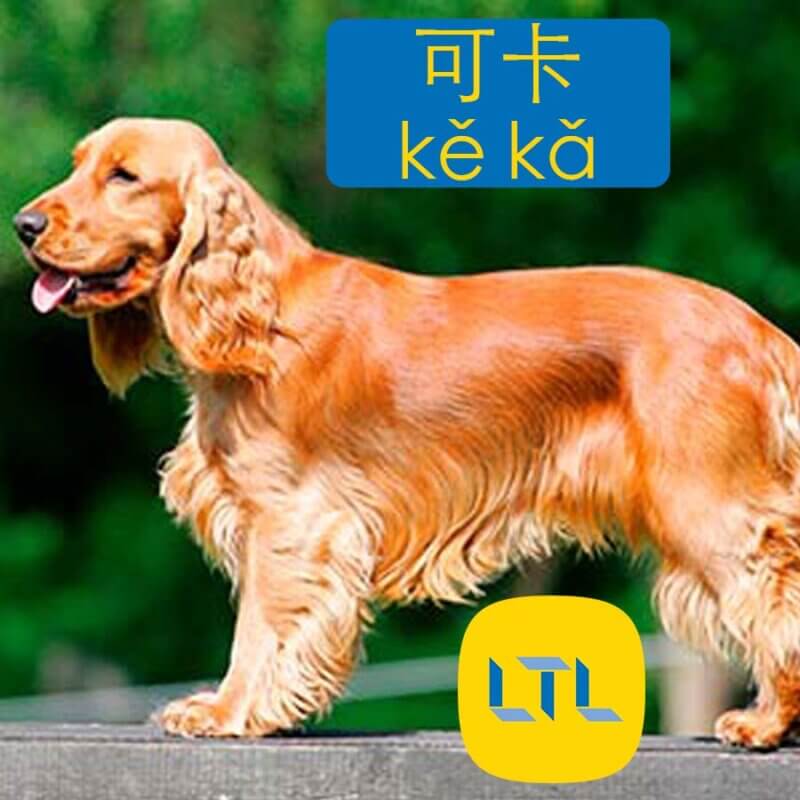












| Dog Breed | Chinese Characters | Pinyin | Literal Translation |
|---|---|---|---|
| Basset | 矮腿猎 | ǎi tuǐ liè | Short Leg Hunting |
| Boxer | 拳师 | quán shī | Fist Division |
| Bulldog | 牛头 | niú tóu | Cow Head |
| Chow Chow | 松狮 | sōng shī | Loose Lion |
| Cocker spaniel | 可卡 | kě kǎ | Can Card |
| Dachshund | 短腿猎 | duǎn tuǐ liè | Short Leg Hunting |
| Dalmatian | 斑点 | bān diǎn | Spot Point |
| Doberman | 杜宾 | dù bīn | Du Guest |
| Husky | 哈斯基 | hā sī jī | What Span Base |
| Mastiff | 英国獒 | yīngguó áo | English Mastiff |
| Newfoundland | 纽芬兰 | niǔfēnlán | New Finn Blue |
| Poodle | 贵宾 | guì bīn | Expensive Guest |
| Pug | 巴哥 | bā gē | Bar Brother |
| Rottweiler | 罗特伟尔 | luótèwéiěr | |
| Saint Bernard | 圣百纳 | shèng bǎi nà | Holy Hundred |
| Sheepdog | 牧羊 | mù yáng | Herd Sheep |
| Spitz | 斯皮茨 | sī pí cí | Span Skin |
Want to know more dog breeds in Chinese? Keep scrolling! We’re getting to the Chinese and Singaporean dogs shortly.
Dog Vocabulary in Chinese
In need of some basic dog vocabulary in Chinese?
What’s the point of knowing the dog breeds in Chinese if we can describe their behaviour.
Beware of the dog 当心狗 dāng xīn gǒu!
| Dog Vocabulary | Chinese Characters | Pinyin |
|---|---|---|
| To Bite | 咬人 | yǎo rén |
| To Sniff | 闻 | wén |
| Barking (dog) | 狗吠声 | gǒu fèi shēng |
| To Bark | 吠 | fèi |
| To Gnaw (bone) | 啃 | kěn |
| To Scratch (claws) | 抓破 | zhuā pò |
| To Play | 玩 | wán |
Dog Body Parts in Chinese
Now time for the dog body parts in Chinese…
| Dog Body Part | Chinese Characters | Pinyin |
|---|---|---|
| Paw | 爪 | zhuǎ |
| Snout | 口鼻部 | kǒu bí bù |
| Mouth (animal) | 嘴 | zuǐ |
| Tail | 尾巴 | wěi ba |
| Whiskers | 胡须 | hú xū |
| Hair (animal) | 毛 | máo |
Taking Care of Dogs in Chinese
If it wasn’t obvious already the author of this article loves dogs.
This next section of vocabulary is very important.
If your Chinese neighbours ask you to take care of their dog, make sure you have the Chinese vocabulary to take care of them!
You’ll really impress them if you can tell them you know their dog breeds in Chinese.
| Animal Care Vocabulary | Chinese Characters | Pinyin |
|---|---|---|
| kennel | 狗窝 | gǒu wō |
| to breed (animals) | 饲养 | sì yǎng |
| to tame | 驯化 | xùn huà |
| to train (animals) | 训练 | xùn liàn |
| to feed | 喂养 | wèi yǎng |
| pet store | 宠物店 | chǒng wù diàn |
| muzzle (for dog) | 嘴套 | zuǐ tào |
| (animal) collar | 颈圈 | jǐng quān |
| name (of the dog) | 绰号 | chuò hào |
| pedigree | 血统 | xuè tǒng |
Chinese Dogs
If you’re about to embark on a trip with us, you had better be prepared for a whole new world of dog breeds in China!
Here’s our breakdown of Chinese dogs.


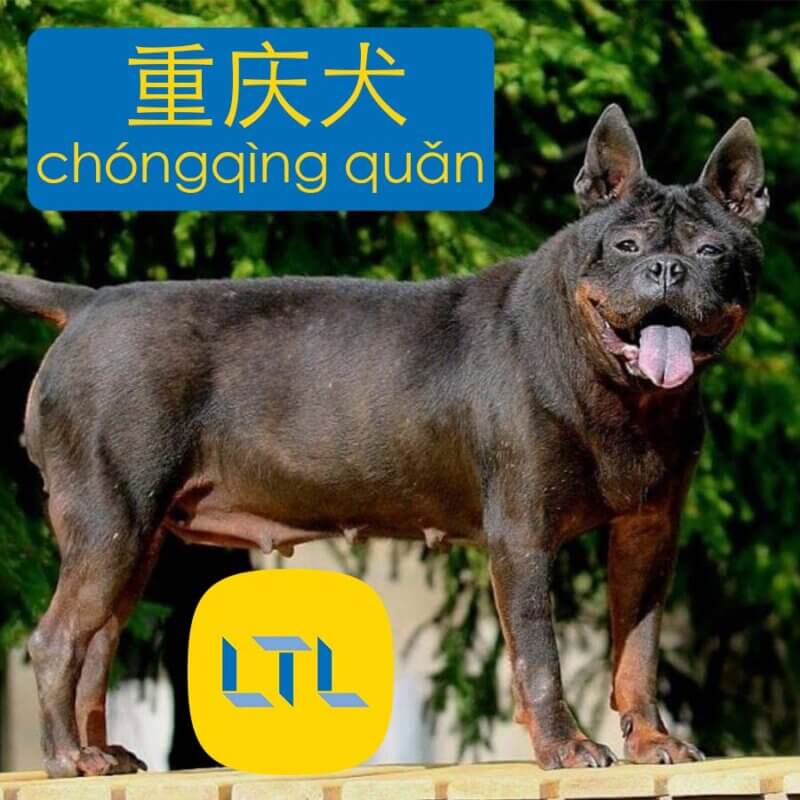

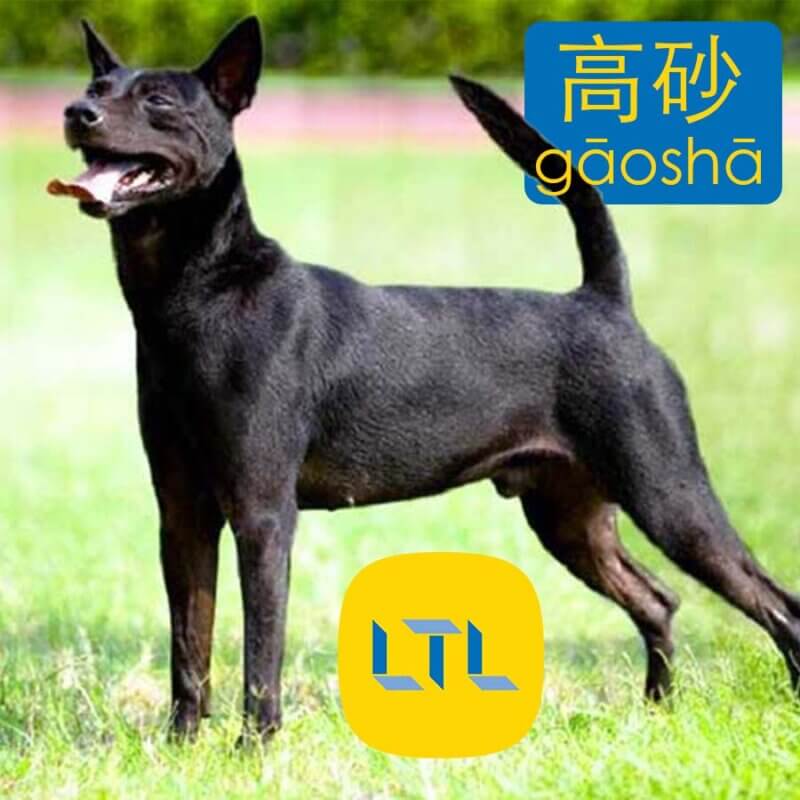



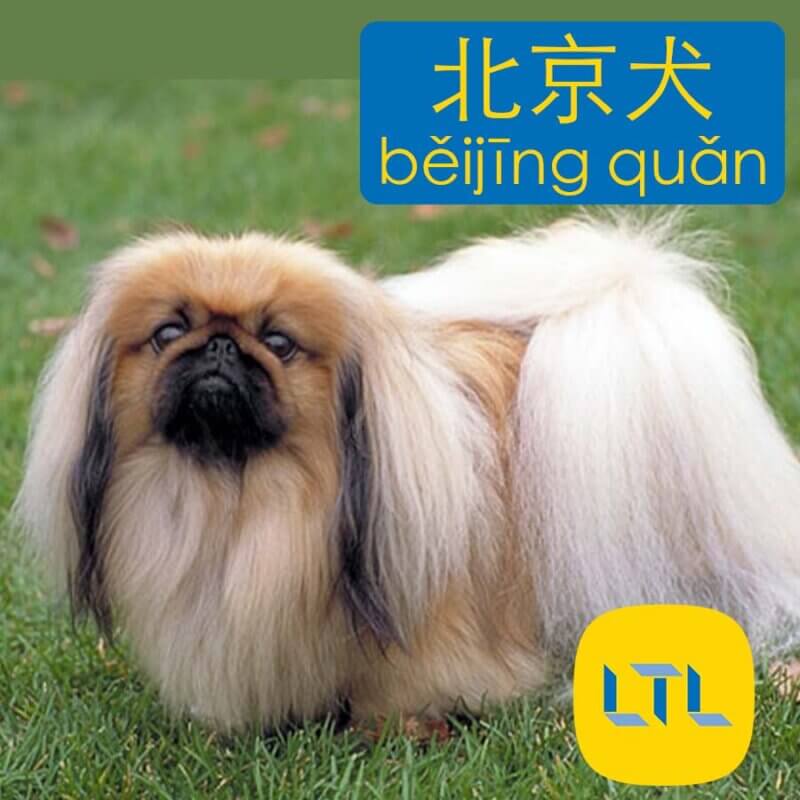

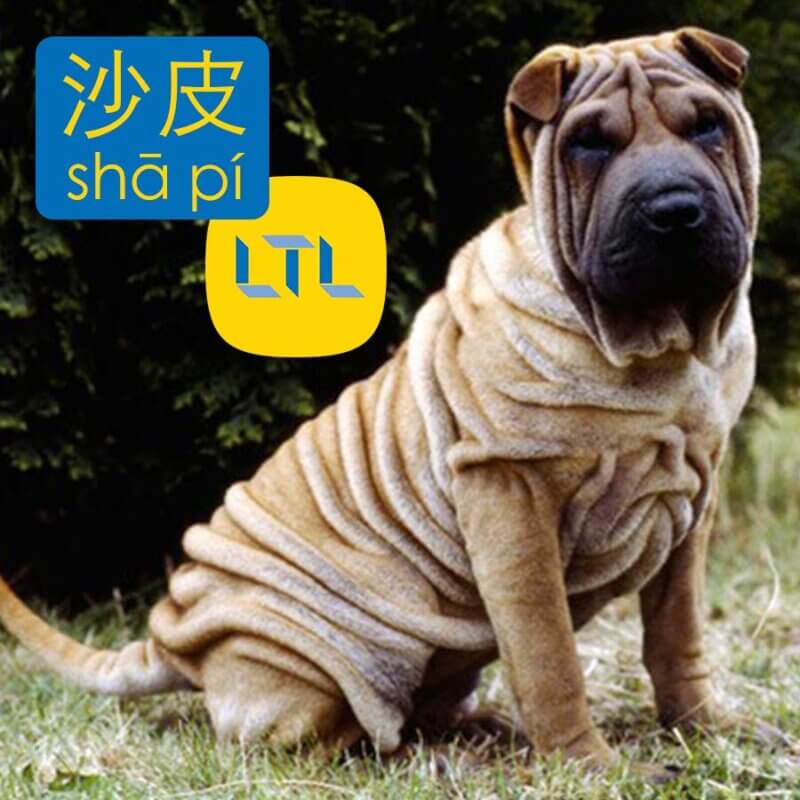

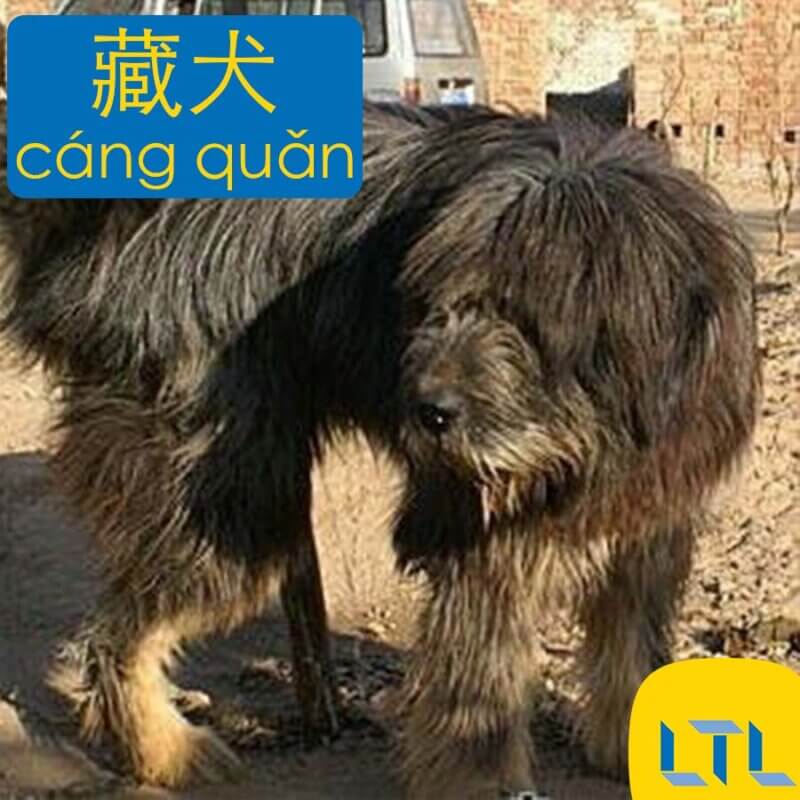



Bone-mouth or Guzui (骨嘴, gǔ zuǐ), translates to “bony snout”. Wouldn’t have been my first choice for a name but he doesn’t seem to mind it. Guzzi’s are best known for being docile and loyal dogs.
Chinese Crested (中国冠毛 hōngguó guān máo) comes in two forms with and without hair. An incomplete dominant trait will lead to the hairless variety. The only distinction is the hair, so will be referred to as either Powderpuff and the Hairless. Hairless was a great companion to Chinese sailors in the 14th-century who’s job was pest control for rats on board. Today they’re a much-loved family member in Chinese homes best known for their playfulness.
Chongqing (重庆犬, chóngqìng quǎn) is referred to as East Sichuan city dog and as you might have guessed is from the Chongqing region. Incredibly, this dog can be traced back to the Western Han Dynasty (BC 202- AD 8). They are great family dogs according to locals.

Chow Chow (松狮, sōng shī) as see above translates to Loose Lion. That’s because of the thick mane they have looking like a lion! Chow Chows are the most independent of Chinese dogs. Often confused as being dumb, they’re in fact stubborn and simply don’t mind being left alone. Typically, they are socialised early they still make an incredibly loyal family member.
Formosan Mountain Dogs (高砂, gāoshā) are not from Mainland China but rather Taiwan. Despite the name, Formosan Mountain Dogs are more commonly seen wandering around cities both wild and domesticated. They’re great dogs for hunting, guarding, and of course, our friends.
Japanese Chin (日本下巴, rìběn xiàbā) as you can imagine has sparked some debate over its origin. It’s believed that these dogs were gifted to Japan by the ancient Chinese Emperors hence seeing them in both countries.
Kunming Wolfdog (昆明狼, kūnmíng láng) is a breed made by the Chinese military. They’re not from Kunming but rather were first used in Kunming for military purposes. As such, its exact origins are hard to pinpoint but they’re likely to be of German shepherd descent. Keep an eye out in China for the Kunming Wolfdog, they’re usually with police and military.

Lhasa Apso (拉萨阿普索 lāsà ā pǔ suǒ) is another breed originating in Tibet. Don’t let this little fluff ball fool you. Despite its cute appearances, the Lhasa Apso was bred by the monks of Tibet as a guard dog.
Pekingese (北京犬, běijīng quǎn) is a Chinese toy dog. Most famously known for only being allowed to be owned by royals in the 8th century (Tang Dynasty). Pekingese are named after China’s capital Peking (Beijing). They’re still a loved pet all over China making a great family member but (and I can attest to this) very arrogant to strangers.
Pugs (巴哥, bā gē) originated from China if you can believe it! Pugs were great companions in Ancient China to the Buddhist monks. Today pugs are still common in China, best known for their friendliness and adaptability to smaller apartment lifestyles.
Shar-Pei (沙皮, shā pí) is an ancient Chinese dog breed, believed to have originated around 200 BC (Han Dynasty) in Southern China. You won’t have a hard time spotting a Shar-Pei in China due to their very unique wrinkly face (see above). ‘Shar-Pei’ is a Cantonese word meaning ‘sandy skin’. They’re very docile and friendly dogs to have around but will be very protective of family members.

Shih Tzu (西施, xī shī) is a toy dog breed. This little guy is all over China. They’re most ideal for the dog lovers in small apartments. They were once a favourite breed of the elite during the rule of the Ming Dynasty. They’re usually happy little fur balls especially around their owners but have been known to bark a lot, especially around strangers.
Tibetan Kyi Apso (藏犬, cáng quǎn) or more commonly known in the west as an Apso Do-Ky. It is a rare Tibetan Collie breed seen most commonly helping farmers with livestock.
Tibetan Spaniel (西藏猎, xīzàng liè) originated from the Himalayan regions of Tibet nearly 2,500 years ago. They’re not actually Spaniels but rather just look alike. Similarly to Lhasa Apso, they’re seen with monks as friends and guard dogs. They’re quite intelligent as they’re known for being able to learn various tricks.
Tibetan Terrier (西藏梗, xīzàng gěng) is not a terrier but rather a Tsang Apso (Tibetan). They’re called the “Holy Dog of Tibet” as they once protected the ancient monasteries of Tibet.
Xiasi Quan (下寺泉, xià sìquán) is a breed of dog originating from Guizhou Province. Often used as a guard dog, the Xiasi Quan has great smell and stamina.
Singapore Special Dogs
There is one last dog we need to talk about.
They’re lovingly called the ‘Singapore Special” (新加坡特辑犬, xīnjiāpō tèjí quǎn).



Singapore Special doesn’t refer to any particular breed of dog but rather a dog that has been bred in the streets.
The genetics of a Singapore Special is almost impossible to pinpoint but here are some images to help give you an idea.
Wait Singapore has street dogs?
The surprising answer to that question is YES. Singapore does have street dogs.
As you can imagine there wouldn’t have been any native dogs roaming around Singapore before man. Rather, these dogs ancestors were introduced to serve as guard dogs for construction sites and factories.
Sadly, as construction finished and factories slowly went away from Singapore a lot of these dogs were left to their own devices.
Today a lot of these dogs still roam the streets of Singapore and occupy a lot of the space in dog shelters.
Animal rights groups in Singapore work with animal shelters to try and find homes for the Singapore Special dogs.
The Dog Quiz!
Hungry Ghost Festival
Learn about the Hungry Ghost Festival and find out why Singaporeans act so strange during the festival.

Dog Breeds in Chinese – FAQ’s
Do they eat dogs in China?
The vast majority of Chinese people don’t eat dogs. There are some parts of China particularly in Yulin where dog meat is still on the menu.
However, these townships increasingly face pressure to stop this cruel practice.
Go to our main website to find out more on the question of do Chinese people eat dog?
How many dogs are there in China?
In 2018 there were estimated to be over 93 million domesticated dogs in China. Owned by 33.9 million Chinese citizen.
How many dogs are there in Singapore?
In 2017 census data indicated around 62,000 pet dogs in Singapore owned by 42,000 dog owners.
What is dog in Chinese?
Dog in Chinese is 狗 gǒu
Want more from LTL?
If you wish to hear more from LTL Mandarin School why not join our mailing list.
We give plenty of handy information on learning Chinese, useful apps to learn the language and everything going on at our LTL schools!
Fancy learning Mandarin online? Check out our online courses here.
Sign up below and become part of our ever growing community!


 Hi, my name is Greta. I am from Italy and I work as a student advisor. Please contact me if you wish to come and study with us!
Hi, my name is Greta. I am from Italy and I work as a student advisor. Please contact me if you wish to come and study with us!









5 comments
I would say this is a great list of Dog Breeds! I love them all!
Thanks Campbell for writing. Shared in my favourite dog groups on Facebook!
Balle Raahauge
Hi Balle, Thanks for the love! We're glad you enjoyed reading it so much. Stay posted for more content you'll love!
I’m seeking a Newfoundlander (purebred) dog in China! Do they exist here and if so, could you provide contact details? Thanks!
Hi Alan, Thanks for your question. Sorry, we don't have the contact details of dog breeders in China. The dog is native to China so you're sure to find one on the online dog forums, Facebook or dog breeders websites.
The name for the Japanese chin is incorrect. Japanese chin is 日本狆犬. Chin is 狆, i.e. combining the radicals for dog and China, and transliterated from the Japanese. Nothing to do with the chin on your face in the article.